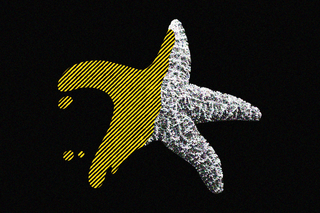
A Mysterious Syndrome Is Turning Starfish Into ‘Goo’
Warming oceans cause microbial blooms that deplete oxygen, causing the creatures to suffocate and become nutrient-rich fodder for bacteria.

Millions of starfish — more accurately known as sea stars — are succumbing to a disease that turns them into “goo” as we speak, and nobody knows why. All scientists have ruled out for now is a virus pathogen as the culprit. But one likely hypothesis is that the condition is triggered by the oceans getting warmer — indirectly leading to us, the purveyors of climate change, as culprits.
The phenomenon began in 2013, when scientists observed purple sea stars and 20 other species melting away for no apparent reason. It spanned from the Gulf of Alaska to Port Philip Bay in Australia — the latter triggered by a massive heatwave.
In a new study, published in Molecular Ecology, marine biologists from Oregon State University studied 200 individual sea stars to see if there were genetic factors that determined which sea stars remained healthy, and which ones began to waste away. Their results found that genetics had little to do with what has come to be known as “Sea Star Wasting Syndrome,” or SSW.
“With little genetic variation to propel adaptation, we definitely have even more concerns regarding how this species of sea star will fare in future outbreaks,” the paper stated.
The implications are dismal. It means that with nothing inherent in the sea creatures to protect them from this mysterious epidemic, they are at high risk of mass extinction. Indeed, the 2013 observation was among the largest mass wildlife mortality events ever recorded.
The death of any species on such a large scale is a tragedy. When it comes to sea stars, the nature of their death paints a dystopic, desolate picture for the friendly ocean critters. “There were arms separating from sea stars, arms walking off by themselves… That was my first experience of the magnitude of it,” Drew Harvell, an ecologist at Cornell University who studies marine diseases, and wasn’t part of the present study, told The Atlantic.
As for what causes it in the first place, evidence points towards warming oceans and a corresponding explosion of phytoplankton blooms. The cycle is a disastrous one: warming oceans and oceanic heat waves cause a bloom in phytoplankton, which consume most of the oxygen. Sea stars then drown in their own habitats from the lack of oxygen; what’s more, bacteria that thrive in low-oxygen environments make their way into the sea stars and damage tissue, research published in Frontiers in Microbiology last year reported.
Related on The Swaddle:
Warming Waters Leave Great Barrier Reef on Verge of Mass Coral Death
The unsuspecting creatures face a double-whammy: abundant nitrogen in their bodies showed that they suffocated to death, while bacteria fed on them. Sea stars are more vulnerable to suffocation due to low oxygen because they “diffuse oxygen over their outer surface through little structures called papulae, or skin gills… If there is not enough oxygen surrounding the papulae, the starfish can’t breathe,” explained Ian Hewson, a Cornell University marine microbiologist, who was part of the 2021 study.
It gets worse. The decaying bodies of sea stars create high-nutrient environments for more microbes to bloom, causing a “horrible feedback loop of sea-star death,” Science Alert notes. And it still doesn’t end here. Declining starfish populations means exploding sea urchin populations — which is bad news for kelp forests. Kelp is a type of seaweed that grows up to a meter, and shelters rich communities of oceanic life. A 2016 paper found that sea star mortality had already reduced kelp cover to a large extent — up to 80% in some areas. With the kelp gone, so too is the entire ecosystem it hosts.Kelp forests also play a role in capturing carbon.
“[I]t is clear that the disease is exacerbated in warmer conditions, and that severe population reductions occurred in warmer southern regions,” the authors of the present study wrote.
“This is a very clear example of a trophic cascade, which is an ecological domino effect triggered by changes at the end of a food chain… It’s a stark reminder that everything is connected to everything else,” said Simon Fraser University marine ecologist Isabelle Côté, who was part of the 2016 study.
All hope is not yet lost for the sea stars. The paper did find a few areas in their genome that showed promising signs of disease resistance — nothing concrete, but not insignificant enough to ignore. The authors urge that future research must investigate this so as to develop potential selective-breeding strategies to save the sea stars.
“With rising sea-water temperatures resulting in a higher prevalence of marine disease, we are likely to see similar scenarios of mass mortality outbreaks impacting marine species more frequently and having little time to address management or conservation plans,” they added.
Rohitha Naraharisetty is a Senior Associate Editor at The Swaddle. She writes about the intersection of gender, caste, social movements, and pop culture. She can be found on Instagram at @rohitha_97 or on Twitter at @romimacaronii.
Related


In Sweden, Crows Are Learning to Pick and Dispose of Cigarette Butts Properly
